外科專科
Dr. Emile Woo
普通外科醫師

Dr. Emile Woo 是一位普通外科及頭頸外科醫師,現任卑詩大學(University of British Columbia)臨床副教授。他致力於新一代外科醫師的培訓,曾擔任聖若瑟醫院(Mount Saint Joseph Hospital)住院醫師訓練協調員,以及「能力本位醫學教育委員會」前任主席。他也是卑詩癌症中心(BC Cancer Agency)胃腸道腫瘤小組成員,現任 Providence Healthcare(聖保祿醫院與聖若瑟醫院)醫療人員主席。
Dr. Woo 畢業於卑詩大學醫學院,並在麥馬士達大學(McMaster University)完成普通外科住院醫師訓練,隨後進一步接受頭頸外科專科訓練。他也曾在新加坡工作並參與當地住院醫師的教學工作。他曾於加拿大及國際多地講課與演講,主題包括高齡外科與胃癌治療。
他亦為「卑詩省胃癌診療指南」的共同作者之一,並持續進行胃癌及手術圍期病人安全相關的研究。目前他正籌備於 2028 年在溫哥華舉辦的「亞太胃食道癌大會」,屆時將擔任會議主席與主辦人。
治療與手術
- 膠囊式大腸鏡檢查 — 將於 2025 年春季回歸
- 胃鏡與大腸鏡檢查
- 胃癌篩檢
- 大腸直腸癌篩檢
- 疝氣治療
- 直腸出血
- 痔瘡及其治療
- 膽囊疾病:結石、息肉與癌症
- 甲狀腺結節
- 超聲波引導甲狀腺細針穿刺活檢
- 雷射痔瘡治療 — 即將推出
膠囊式內視鏡檢查
無需侵入性操作,即可觀察大腸影像!
許多人都知道大腸鏡檢查是大腸癌篩檢的黃金標準。不過,這項檢查屬於侵入性程序,確實存在導致腸道受傷或穿孔的風險;此外,大多數患者在檢查時還需接受鎮靜才能忍受整個過程。
如今,有了一種不需使用傳統內視鏡的替代方式來觀察大腸,而且不像電腦斷層(CT)大腸攝影,這項新技術無需輻射,並可取得實際彩色影像,而非黑白的數位圖像。目前,英國已開始將膠囊式大腸鏡應用於大腸癌的初步篩檢中。
PillCam Colon2 是什麼?
PillCam Colon2 是一顆兩端各有一組鏡頭的膠囊,可每秒拍攝多達 30 張影像。它會將影像傳送至一個患者身上所配戴的記錄裝置中。檢查完成後,資料將上傳至電腦,由我們的專科醫師進行分析。
優點包括:
不需鎮靜
無穿孔風險
無輻射暴露
患者需在檢查前接受腸道清潔,以確保膠囊能清楚拍攝腸道內部。不過仍有少數風險,例如:
約 1% 的病患可能出現膠囊無法排出的情況
若腸道蠕動較慢,可能導致影像不完整
有興趣了解 PillCam Colon2 是否適合您?歡迎立即聯絡我們。
胃鏡與大腸鏡檢查
檢查胃部與大腸的最佳方式,是使用可彎曲的內視鏡。內視鏡的前端配有高亮度 LED 燈與攝影系統,可提供高解析度的影像畫面並加以記錄。內視鏡中還包含通道,可進行吸引及放入小型手術器械,用以進行組織切片或切除如息肉等組織。
胃鏡(Gastroscopy)
胃鏡主要用於檢查胃部狀況,常用於評估胃痛的患者,也可用於診斷:
胃潰瘍
胃部息肉
胃酸逆流(GERD)
胃癌等疾病
大腸鏡(Colonoscopy)
大腸鏡檢查是檢測大腸癌的黃金標準,也可用來評估:
腸道發炎
腸道出血等問題
大腸鏡需要事先進行腸道清潔,以便清楚觀察腸道內部,這通常在檢查前一天進行。
內視鏡是一項非常常見且安全的檢查方式,但仍存在少數風險:
大腸鏡可能造成腸道損傷或穿孔,但多數情況可無需手術治療
若大腸過於彎曲或過長,約有 1% 機率無法完整觀察整段腸道
約有 1% 的患者可能因腸道狀況而錯過早期小型癌症
關於鎮靜與舒適性
無論是胃鏡還是大腸鏡,為了讓患者舒適進行,通常都需要某種程度的鎮靜。
在 PEH,我們可為您迅速安排胃鏡與大腸鏡檢查,地點可選擇:
私人診所(提供靜脈注射鎮靜)
私人外科設施(由麻醉科醫師進行,可提供類似全身麻醉的無痛檢查體驗)
胃癌篩檢
鋇餐攝影被視為較早期的胃癌篩檢技術。其原理是讓患者飲用一種 X 光顯影劑(鋇劑),使其覆蓋在胃黏膜表面。接著拍攝 X 光影像,呈現出胃的輪廓(如圖 1)。
放射科醫師會根據這種間接的胃部輪廓影像來判斷是否有腫瘤或潰瘍的存在。
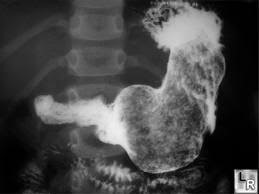
圖一:鋇餐攝影所呈現的胃部輪廓
胃鏡檢查雖然屬於較侵入性的檢查方式,但它能讓我們直接觀察胃黏膜的表面。
正因如此,胃鏡能夠發現早期變化,這些變化在鋇餐攝影中是無法察覺的。鋇餐必須出現較明顯的結構改變(例如腫塊或變形)才能被檢查出來;若只是輕微的顏色改變,沒有顯著的結構異常,是無法透過鋇餐檢查看見的(如圖二)。
胃鏡檢查可以非常近距離觀察病灶,並可搭配不同的影像濾鏡來強化觀察效果。圖中的癌症病灶非常微小、難以察覺。
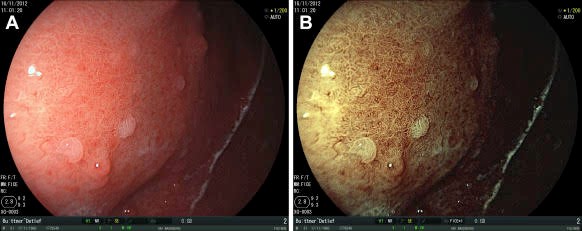
圖二:在不同濾光模式下胃鏡所見的早期胃癌
因此,胃鏡檢查能夠更早期發現胃部的變化,讓我們得以在癌症發展之前就加以預防,或在早期就偵測並治療癌症。
此外,一旦發現異常變化,我們可立即進行組織切片(活檢),這是鋇餐攝影所無法做到的。
總體而言,胃鏡的診斷效果遠優於鋇餐攝影。
值得注意的是,加拿大受過早期胃癌診斷訓練的專業醫師非常少,因為此病在本地較為罕見。
本地鋇餐攝影的品質也遠不如日本(尤其是在非醫院的檢查中心品質偏低)。
即使在醫院內,放射科醫師通常也未受過針對胃癌篩檢的專業訓練。
及早發現胃癌至關重要。
發現得越早,治療效果越好。這正是為什麼在日本胃癌治療成效遠優於其他地區的原因之一 —— 因為發現得早。
而在美國與加拿大,大多數患者在發現時已屬晚期。
從圖三可以看出,日本有 53% 的病例在局部期(Localized)即被診斷出來;
相比之下,美國(與加拿大)僅有 27%,大多數案例在發現時已出現區域性擴散或遠端轉移。
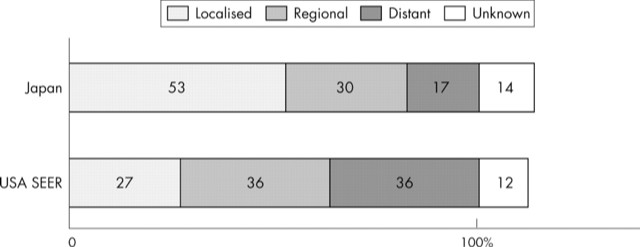
圖三:日本與美國胃癌病例的分佈情況比較
對於日本與韓國客戶而言,由受過胃癌相關訓練的醫師進行篩檢格外重要。
Dr. Woo 是溫哥華少數具備胃癌診療訓練背景的外科醫師之一。
大腸直腸癌篩檢
什麼是大腸直腸癌?
大腸直腸癌是指**起源於大腸與直腸內層黏膜(黏膜層)**的癌症。
在加拿大,大腸直腸癌是第三常見的癌症,也是癌症死亡的第二大原因。
隨著亞洲國家發展進步並逐漸採用西式飲食習慣,大腸直腸癌的發生率也逐年上升,並逐漸趨近於西方國家的發病率。
從下方圖表可以看出,中國的大腸直腸癌發病率在男性與女性中皆呈現穩定上升趨勢。
(數據來源:Chen, W 等人,2015,CA)
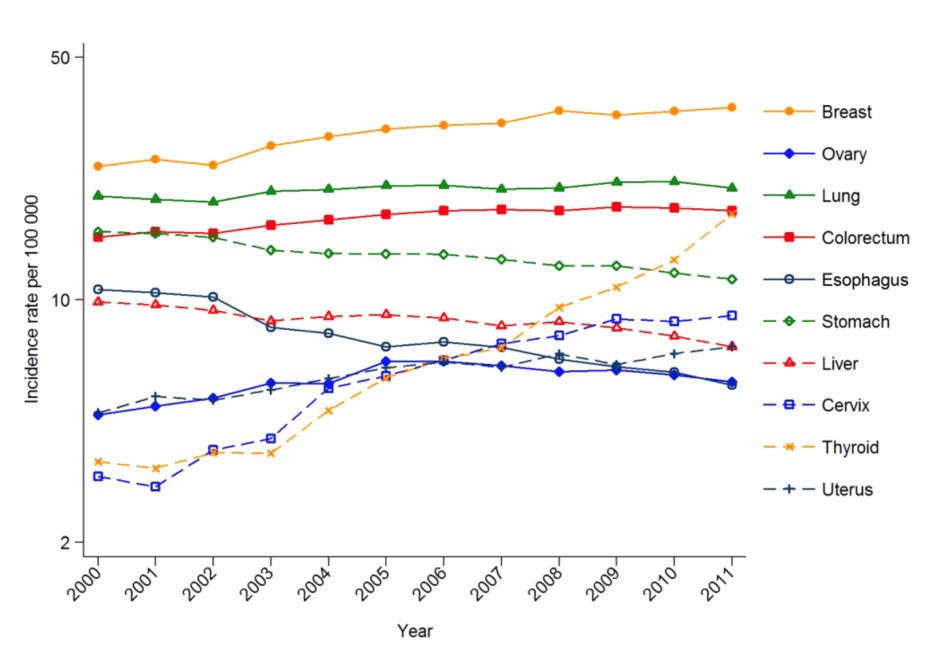 Figure 1: Rates of Cancer in Females in China (2000-2011)
Figure 1: Rates of Cancer in Females in China (2000-2011)
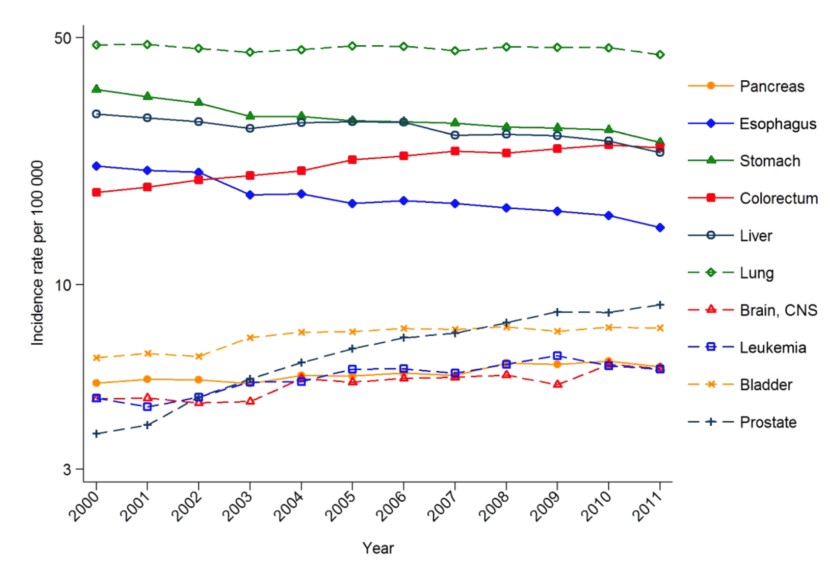 Figure 2: Rates of Cancer in Males in China (2000-2011)
Figure 2: Rates of Cancer in Males in China (2000-2011)
為什麼要做篩檢?
不幸的是,就像大多數癌症一樣,大腸直腸癌在早期通常沒有任何症狀,也就是說,完全無徵兆。
隨著癌症的擴大,可能會出現以下症狀:
出血
排便習慣改變
無法解釋的體重減輕
不明原因的貧血
然而,這些症狀通常在癌症已較為進展時才會出現。因此,進行**篩檢(也就是在無症狀的情況下進行檢查)**是偵測大腸直腸癌的最佳方式。
此外,大腸直腸癌往往源自腸道黏膜內的小型增生物,稱為「息肉」。
篩檢可以早期發現這些息肉,並透過移除息肉來預防日後癌症的發生。
誰應該接受篩檢?
大腸直腸癌最主要的風險因素是年齡。如表一所示,隨著年齡增長,罹患癌症的風險也會逐漸上升。

有哪些篩檢方式?
FIT 測試/糞便潛血檢查
目前,省政府建議使用 FIT(糞便免疫化學檢測) 作為初步篩檢方式,
適用於50 歲以上、無家族病史(無 60 歲以下直系親屬患癌,或兩位直系親屬患癌)的民眾。
FIT 測試用於檢測腸道內是否有異常出血,這可能與癌症或大型息肉有關。
此測試非常安全,不需任何腸道準備程序。
若 FIT 檢測呈陽性,則需要進一步進行大腸鏡檢查,以確認是否有癌症或息肉。
FIT 測試有約 5% 的機率會漏掉癌症或大型息肉,
並且無法檢測早期或體積較小的息肉。
大腸鏡檢查(Colonoscopy)
大多數外科醫師與內科醫師團體認為,大腸鏡檢查是大腸癌篩檢的黃金標準。
對於有家族病史(一位 60 歲以下直系親屬,或兩位直系親屬罹患大腸癌)的患者,
大腸鏡檢查亦被推薦為首選方式。
該檢查使用一條長而柔軟的管子,末端附有攝影鏡頭,可觀察整段大腸的內部情況。
大腸鏡可檢出 99% 的大腸癌病例,並能同時進行組織切片與息肉切除。
不過,此檢查需先進行腸道清潔準備,並且因可能造成不適或疼痛,
大多需要靜脈鎮靜輔助。
風險方面,大腸鏡有約 1/1000 的機率造成腸道損傷或穿孔,
死亡風險約為 1/10000。風險可能會隨年齡增加而升高。
PillCam Colon2 — 膠囊式大腸鏡檢查
膠囊式內視鏡是一項新型技術,患者只需吞下一顆兩端各裝有攝影鏡頭的膠囊,
即可完整拍攝整段大腸與直腸的影像。
此方法適合不願接受侵入式檢查或對穿孔風險有所顧慮的患者。
膠囊內視鏡仍需進行腸道清潔準備,但不需要鎮靜,且無穿孔風險。
風險方面,大約 1% 的患者可能出現膠囊滯留。
若檢查中發現異常,仍需進一步進行大腸鏡來切片檢查。
此外,膠囊鏡對於 小於 5–6 公釐的病灶可能無法偵測。
CT 大腸攝影(CT Colonography)
CT 大腸攝影是一種針對腸道的專門電腦斷層掃描技術,
被視為大腸鏡檢查的一種替代方案。
檢查前,患者也需進行腸道清潔,並飲用顯影劑以覆蓋腸道黏膜。
檢查時,需由肛門灌入 CO₂ 氣體以撐開腸道,接著進行 CT 掃描。
該檢查有輕微穿孔風險(因灌氣造成壓力),且無法偵測 6mm 以下病灶。
此外,影像為電腦生成黑白畫面,無法如內視鏡般顯示真實色彩,
也因此無法準確評估腸道發炎情況。
需要大腸癌篩檢?想了解各種檢查方式?
在 Pacific Executive Health,我們能提供全系列的大腸癌篩檢選項,
歡迎聯繫我們,了解最適合您的檢查方案。
Hernia Treatment
What is a hernia?
Hernias occur when there is an abnormal protrusion of an organ into an area where it usually is not supposed to be. The most common hernia is what is called an inguinal hernia. These are due to a tear or disruption of the strength layer of the abdominal wall in the groin. Normally, the muscles and fascia of the deeper layers of the abdominal wall provides strength and holds the abdominal organs inside. In a hernia, there is essentially a hole in the muscle and fascia layer such that the organs inside the abdominal cavity (such as the intestines) now protrude outwards under the skin. Other hernia types include femoral as well as incisional hernias.
What happens if the hernia is not repaired?
Over time, the hole will enlarge and more of the internal organs will push out and therefore the hernia will become larger. How quickly this happens is unpredictable. As the hernia enlarges, it can become more painful and inconvenient. Many patients with hernias are unable to exercise or may have lots of pain with prolonged standing or walking.
The most concerning aspect of a hernia is the risk of what is called incarceration or strangulation of a hernia. This is when one of the internal organs, such as the intestine, comes through the defect/hole in the abdominal wall and gets trapped or twisted and cannot be reduced/pushed back into the abdominal cavity. If this happens, it can be an emergency. Usually, patients will feel sudden, severe pain at the bulge of the hernia and may feel nauseated or vomit. This needs to be treated within 6 hours or else the portion that is trapped outside may become gangrenous.
How are hernias repaired?
Hernias can only be repaired using surgery. There are no exercises or medications that can be used to close the hole. In the short term, patients with symptoms can purchase a hernia belt to try to hold in the hernia and prevent symptoms.
Surgery involves reducing all of the organs that have come out back into the abdomen and then repairing the hole by placing a mesh made of a plastic polymer to patch the whole. The surgery can be done using either a small 5 to 7cm incision in the traditional way or via 3 small openings using a laparoscopic technique. Surgery usually is requires under one hour and patients may go home the same day.
If you have a hernia, Pacific Executive Health can arrange a rapid assessment with Dr. Emile Woo. We also have access to private surgical facilities so that you will not have to wait for months to have your hernia repaired while you are suffering from pain and unable enjoy the activities you want to do. Dr. Woo has performed thousands of hernia surgeries and can perform both traditional open surgery as well as advanced Laparoscopic surgery.
Rectal Bleeding
Rectal bleeding is a very common condition. However, seeing blood in the toilet can be a very frightening experience as even a small amount of blood can stain the water very red.
The vast majority of patients who experience rectal bleeding do not have anything ominous or worrisome. However, even just one episode of rectal bleeding should require an assessment with a doctor to confirm that it is due to a benign reason.
The most common causes of rectal bleeding are:
- Bleeding internal hemorrhoids
- Anal Fissures
- Anal Fistulas
More serious causes of rectal bleeding are:
- Colon or rectal cancer
- Bleeding from diverticular disease
- Inflammatory bowel disease
- Food poisoning
Many people are concerned about the risk of colorectal cancer. Patients that have the following symptoms along with their bleeding may require a colonoscopy to be sure:
- Blood that is mixed into the stools
- Blood that is dark (not bright red) or there are clots
- Altered bowel patterns
- Unexplained weight loss
- New onset urgency with having a stool
- A family history of colorectal cancer in a first degree relative
If you have lots of bleeding, you should go to your nearest Emergency Department.
At Pacific Executive Health, we can arrange for a rapid Assessment including a same day scope of the anus and rectum for diagnosis of hemorrhoids, fissures, inflammation, as well as rectal cancers. We can also schedule private screening using colonoscopy or pillCam Colon if required. Treatment of your hemorrhoids can be provided as well.
Hemorrhoids and Treatment
What are hemorrhoids?
Hemorrhoids are normal cushions of tissue that are situated around the anal canal. They help with the normal opening and closing of the anal sphincter. Everyone has hemorrhoids. However, when people speak of having hemorrhoid problems, it usually refers to the fact that they have enlarged and can bleeding, prolapse, or become swollen and painful.
Hemorrhoids are divided into either External or Internal Hemorrhoids.
Internal hemorrhoids are found within the anal canal and are normally not seen. When internal hemorrhoids enlarge, they can either bleed or prolapse out. Internal hemorrhoids, as they are internal, normally do not have any nerve endings and therefore do not have any sensation. Most people will have painless, bright red blood when they bleed. If they prolapse, patients may feel a sense of some tissue coming out. If the hemorrhoid is not very large, it will usually reduce, that is, go back inside, on their own. If it is larger, patients may have to use their hand to push it back in.
Normally, treatment of internal hemorrhoids does not require surgery anymore. They are usually quite easy to treat by either injecting them with a medication that causes the hemorrhoid to shrink or shrivel up. Another common way of treating hemorrhoids involved placing a small rubber band across the base of the hemorrhoid. This will then cause the hemorrhoid to fall off over a few days. Surgery is only required for very large hemorrhoids.
External hemorrhoids are found on the outside of the anus. They show up as bulges of tissue that look like grapes or may be flat like the petals of a flower. Normally, external hemorrhoids are not symptomatic and are very common. However, in a small number of patients, they may become swollen and inflamed. This can be extremely painful. External hemorrhoids, as they are covered by skin, are very sensitive and can only be treated with surgery and usually requires a general anesthetic.
If you have hemorrhoids, Pacific Executive Health can arrange for a rapid assessment so that you can be diagnosed and treated quickly.
Gallbladder Disease: Stones, Polyps, and Cancer
What is the Gallbladder?
The gallbladder is a storage organ for bile. Bile is required to help you digest fats in your food. It helps to emulsify the fat into water so that your body can absorb it. Bile is not made in the gallbladder but is made in the liver.
Gallstones
Gallstones are very common in the normal population. In North America, the number of people who have gallstones is between 10-15%. It may be as high as 50% in some groups of people such as Aboriginal Canadians. Asians also tend to have higher rates of stones and usually have different types of stones from Caucasians. Caucasians tend to have cholesterol stones whereas Asians tend to have pigmented stones that are black or brown.
Most patients (80%) who have gallstones do not have any symptoms. Only a small minority do. The typical symptoms are:
Pain after eating fatty foods
Pain that is severe and constant
Pain that is in the epigastric/upper mid abdomen or to the RIGHT, just under the rib-cage
With a severe attack, the pain can go into the back and into the shoulders
Surgery is the only definitive cure for patients who have gallbladder symptoms. The preferred method is to remove the gallbladder using laparoscopic surgery using 4 small incisions.
Gallbladder Polyps
Gallbladder polyps are very common. The vast majority of polyps are small, and benign. They are usually made up of cholesterol that has become attached to the gallbladder wall and the appearance, on ultrasound, shows a polyp like growth. However, gallbladder polyps that are greater than 1cm are associated with a risk of cancer and laparoscopic surgery is recommended to prevent cancer.
Gallbladder Cancer
Gallbladder cancer is very rare in North America. However, gallbladder cancer is very difficult to treat as the gallbladder is very thin and therefore cancer spread occurs very easily. As well, there are some places where gallbladder cancer is more common, such as in Shanghai, China. Symptoms of gallbladder cancer is usually very vague and occurs late. The only proven method of treatment is early diagnosis and surgical removal of the gallbladder.
If you have a gallbladder problem, Pacific Executive Health can arrange for a rapid assessment with one of our experienced surgeons. We can also arrange for private surgery with the long wait that is usual in the public system.
Thyroid Nodules
What is the thyroid?
The thyroid is a small, butterfly-shaped organ that is located at the base of the neck. It is responsible for secreting Thyroid Hormones which are responsible for regulating your bodies metabolic rate.
What are thyroid nodules?
Thyroid nodules are abnormal growths within the thyroid itself. Nodules are very common in women with up to 50% of women having nodules by the age of 50. Around 95% of nodules are benign/non cancerous. The may be caused by hormonal changes, family history, as well as certain dietary factors.
How do you know if my nodule is benign or cancerous?
There are a number of risk factors for thyroid cancer. These include radiation exposure at childhood, being of child bearing age, certain countries have a higher risk of thyroid cancer such as in China where there is a rising incidence, as well as family history for thyroid cancer.
The most important test to know whether a nodule is benign or not is via a Fine Needle Aspiration. In this test, a small needle is inserted into the nodule and cells are taken out and sent to a lab for analysis. The procedure can be done in the office and usually takes under 10 minutes. A result will usually come back in under 1 to 2 weeks.
At Pacific Executive Health, we can arrange for a rapid Assessment with our experienced thyroid surgeon. We may be able to perform a biopsy for you on the same day. Contact us if you have any questions.
US Guided Needle Biopsy - Thyroid
Starting in 2025, our surgeon will be offering Private US guided Fine Needle Aspiration for Thyroid nodules.
-accurate localization of thyroid nodules
-simple, 5 to 10 min procedure without the need for anesthesia
-98% accuracy in determining the type of nodule (all samples are sent to expert cytologists for interpretation)
-we can arrange to have this done within 2 to 3 weeks (vs 6 months or more in the public system)
-if you require surgery, our surgeon can arrange for expedited surgery
For patients who do not have BC MSP, before we can perform a biopsy, we require:
1. Your Thyroid Ultrasound showing which nodule(s) require biopsy
2. A virtual consultation with our surgeon
For patients with BC MSP, you will require:
1. a referral from your Primary Care Provider to Dr. Emile Woo
2. Your Thyroid Ultrasound showing which nodule(s) require biopsy
3. An in person or Virtual consultation with our surgeon
